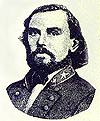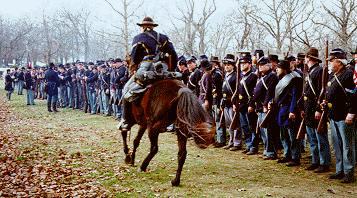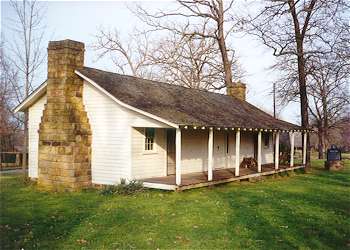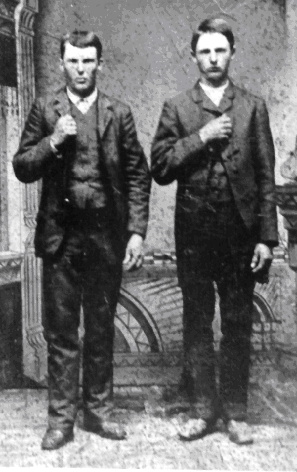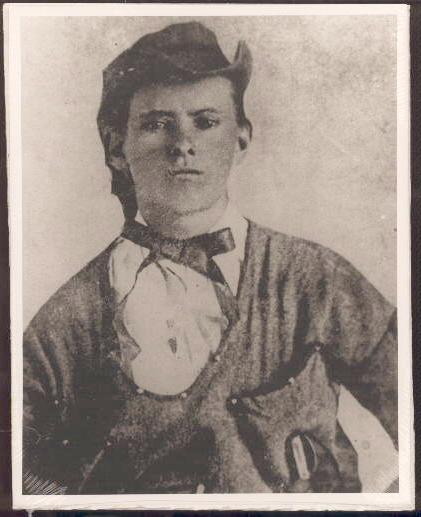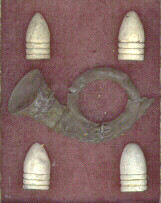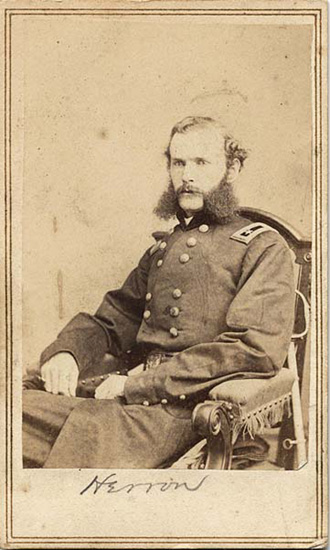Learning of the rapid approach of Herron's army, Hindman bypassed Blunt at Cane Hill and turned north to attack Herron's army near Prairie Grove Church on December 7th. The fighting began at dawn on a beautiful and mild Sunday morning, when Confederate cavalry routed the forward cavalry regiments of Herron's army about one mile south of the Prairie Grove Church. As Hindman pursued the cavalry, he met Herron's infantry which pushed him back. Hindman's men took a defensive position on a high wooded ridge northeast of Prairie Grove Church overlooking the Illinois River. Herron brought his artillery across the river and initiated an artillery duel that opened the way for a Union attack. Between noon and 2 PM, two Union charges met with bloody repulse. The confederates counterattacked, were halted by Union canister, then moved forward again.
At 10 AM that morning, General Blunt had begun to fall back with his command towards Rhea's Mills to join General Herron. The last five miles of the march of General Blunt's Division was made at double quick, stimulated at hearing the roar of artillery and musketry. At 3 PM, just when it looked like the Rebel attack would roll over Herron's troops, Blunt's men arrived and assailed the Confederate left flank. The arrival of Blunt extended the battle lines the full length of Prairie Grove ridge, almost two miles. The heaviest fighting shifted to the vicinity of the William Morton home where four families hid in the cellar. The 13th Kansas Infantry was among the first of Blunt's men to take position on the battlefield. It formed a line of battle between the 10th and 11th regiments, on the right of the main command. Standing in a thick wood just under the protection of a slight eminence of the ground in front they, engaged against superior numbers. They were supporting the 2nd Kansas Howitzers and one section of the 1st Kansas Battery. Several attempts were made to capture the batteries, but were repulsed. The confederates concentrated their attacks on Blunt, but Union artillery gave the Federals a clear advantage, even as desertions further depleted the Confederate numbers. One final Confederate charge, about 5 PM, faced the wrath of all 44 Union cannons and was torn to pieces. Darkness ended the struggle. The regiment, with the division, retired a few hundred yards from the battlefield and bivouacked in the edge of an open space for the night. They slept without campfires and very few blankets or tents despite freezing temperatures, expecting the attack to renew the following morning.
The caissons in Herron's batteries were nearly empty. He dispatched a messenger up the Fayettville road in search of the ammunition train. The messenger was told that he should find it five miles beyond Fayettville and that it could not be as far away as Cross Hollows. He was directed to ride until he met it and urge it forward. The man burst into Elk Horn Tavern and enquired about the train. A detail was dispatched from the tavern. They galloped up the road to Keitsville. Ten miles away they found it parked without a guard. The ordinance officer had pushed on without a guard, although it was perilous to do so. Thirty five men from Elk Horn tavern were used as guards, leaving only five men to defend the position at the tavern.
|

